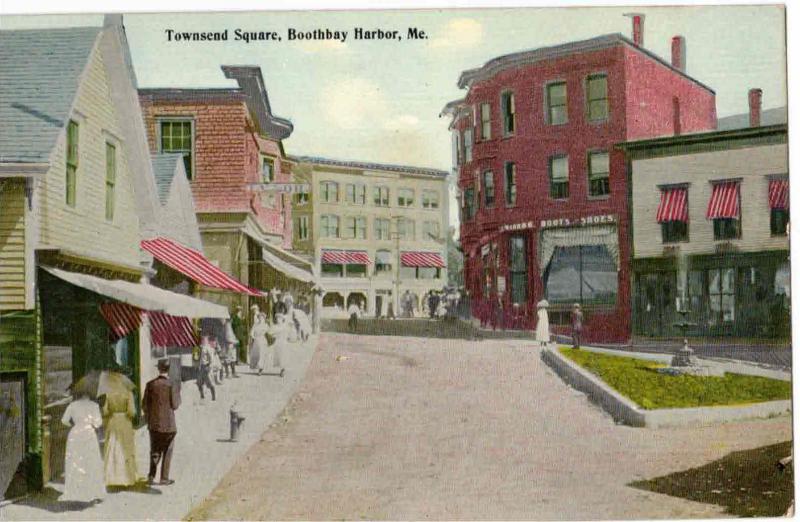Many people remember when there was a traffic island in what was called Custom House Square in Boothbay Harbor. Though many think that the triangle had been the site of a horse trough, that was not the case. How that little oasis came to be there follows, with help from old Boothbay Registers.
Students of local history know that at the turn of the century Luther Maddocks was an influential man in the Harbor. He, like so many other successful Harbor men, left Southport and settled in the Harbor to pursue his enterprises. Luther was instrumental in building pogie factories, bone factories, dogfish factories, sardine factories, fire prevention, electrification, the footbridge, the opera house — any forward-looking enterprise drew his attention and support. The Railway Village on Route 27 is fortunate to have his never-realized plan for a railroad to Boothbay. Luther Maddocks was proud of his town and wanted to infect others with his pride. The footbridge and the opera house, two of his projects, were symbols of a community taking pride in itself and Maddocks' trips to American cities must have brought him face-to-face with many fountains; he brought the idea home.
The 1910 Fountain
A fountain was erected in Custom House Square as described in the June 25, 1910 Boothbay Register: “The new electric fountain is in running order and is a novel and beautiful sight in the evening, showing in the spray all the colors of the rainbow. The beach rock base and fountain is in good taste and very fitting for our locality. With a few changes and improvements it can be made a great ornament to the square."
A few years before I saw this news items, Asa Tupper Sr. (born 1898) of Boothbay Harbor told me about the fountain. His description reminded me of the times in the 1950s when I'd seen Niagara Falls at night with colored lights played on the Falls. The effect here must have been the same but quite a bit smaller.
Asa recalled that he used to look out on the fountain plot from his law office in Custom House Square and the plot often looked ragged. One year during his tenure as selectman in the mid-1920s, Asa purchased 100 red tulip bulbs, wheeled them down street near daybreak, and planted them in the fountain plot.
Asa was a great admirer of Luther Maddocks' many legacies, but he regretfully reported that the fountain was not a success. The electric component often broke down; and if the wind came up, the water thrown up by the fountain was blown into the street, instead of cascading down into its intended target and drain. The idea was great but the engineering and execution were only human.
The fountain, with its attendant problems, inspired ideas for other uses for the plot. One short-lived idea, told to me by Red Giles, was a plan to move the Civil War monument from Boothbay Center down to the Harbor to rest on the spot. Given the respective sizes of the plot and the statue, the soldier's toes would have been nipped by traffic, had the plan succeeded.
The Triangle Is Removed
I ran across a later 1930s news item on the fountain plot, which follows: “When the cement work around the former fountain in Reed Square was torn away today by workmen under Elbridge A. Giles (grandfather of the present Elbridge), the men came upon a glass bottle embedded in the cement. The bottle contained the following data: ‘Finished May 21, 1910. Workmen R. G. DeWolfe, boss George Larrabee, Sam Cronk, D. H. Moody, Albert Cottle, Alvah Webber, Willard Benner, Robert M. Wylie. Written by Robt. M. Wylie, May 21, 1910.’
“The little triangle is now no more, only left being a circle of earth and cobblestones, where once a beautiful fountain played. It is considered a legal requirement that this fountain aspect be preserved, but as it is it will be a useless monstrosity.
“The Register suggests, now that the drinking fountains [the watering troughs for thirsty horses] are all being abandoned, that a pretty little spray fountain be maintained in this square. It will be necessary to put a base of some kind around the little circle plot. Pipes are still in position. There ought to be enough water in Adams Pond to permit this. Unless a fountain is maintained the town should take a chance of losing the plot and tear down the whole structure. If the loss of the fountain brought down legal action to return the land to the heirs or donors it might then be condemned and taken for public use.”
Walter Reed II, a lifelong Boothbay Harbor resident, remembered mowing the grass on the triangle when he was 11 or 12, which puts the grassy triangle still there up through the 1930s. The second picture, taken in 1947 shows just the fountain base/geranium planter left and I believe that remnant lasted a while longer. Two people told me the little plot was finally obliterated and paved over in the early 1950s. The increasing presence of cars put the little plot on a collision course with oblivion. It became an obstacle, not an oasis, with a multitude of fender benders bringing down the wrath of drivers.
































